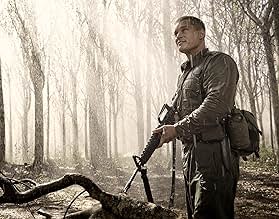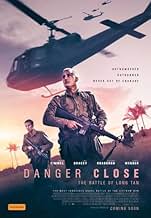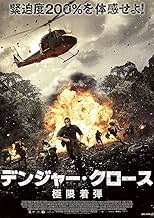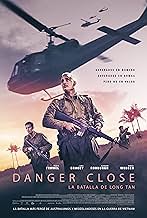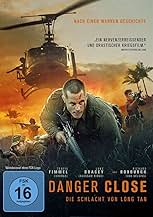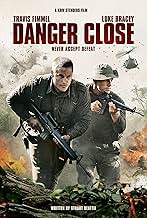ÉVALUATION IMDb
6,8/10
16 k
MA NOTE
En août 1966, dans une plantation de caoutchouc vietnamienne appelée Long Tan, 108 jeunes soldats australiens et néo-zélandais, se battent pour leur survie contre 2500 soldats nord-vietnamie... Tout lireEn août 1966, dans une plantation de caoutchouc vietnamienne appelée Long Tan, 108 jeunes soldats australiens et néo-zélandais, se battent pour leur survie contre 2500 soldats nord-vietnamiens et viet-cong.En août 1966, dans une plantation de caoutchouc vietnamienne appelée Long Tan, 108 jeunes soldats australiens et néo-zélandais, se battent pour leur survie contre 2500 soldats nord-vietnamiens et viet-cong.
- Prix
- 8 victoires et 6 nominations au total
Rihari Te Are
- Gunner Murry Watene
- (as Richard Te Are)
Histoire
Le saviez-vous
- AnecdotesThe term, "Roger that", is an Americanism, originally from CB radio culture, and often used in military movies. However, it would never be said (or permitted, by any NCO or Officer within earshot) in the Australian Army. "Roger" is the only accepted proword. Similarly, the phrase, "I repeat", when repeating some for clarity over the radio telephone (RATEL), is not permitted. Instead the operator would use, "I say again...". This is because "repeat" is a proword used when directing artillery or naval fire (e.g "request for the same volume of fire to be fired again with or without corrections or changes")
- GaffesThe entire battle took place in a torrential tropical downpour from start to finish. Evidently, this would be hard to film for dramatic purposes. The airstrike never happened not because of a dud smoke grenade, but the cloud was so low and rain so intense the pilots could not identity the target area.
- Citations
Major Harry Smith: There's a thousand ways to die in a war zone.
- Générique farfeluPart way through the final credits, after showing the actors and pictures of their real life counterparts and some of the principal credits, acknowledgment of the 6RAR's Presidential Unit Citation from the USA made in 1968 but that Australia took 45 years to acknowledge the soldiers who fought in a similar way.
This is followed by an Honour Roll of the Australian Soldiers killed during this battle.
- ConnexionsFeatured in Danger Close: Behind the Scenes (2019)
Commentaire en vedette
A lot more soldiers have been killed in single battles in other wars, but not boys from a nation so young as ours was in Vietnam, August 1966.
Director Kriv Stenders honed his craft in 20 years of Australian television before tackling the sticky subject of our involvement in the Vietnam war, for the big screen. The story he chose, the battle of Long Tan, eptiomises the mess Vietnam was for anti-communist allied military.
Our small number of troops had no fighting experience in the terrain and climate of south east asia. Our government instated conscription to find the troop numbers it was tasked with sending, in support of the U.S., New Zealand, and a handful of developing anti-communist asian countries. North Vietnam (communist Viet Cong) were well equipped by the U.S.S.R. and China, and knew their battle ground well. This battle of Long Tan story isn't a turning point in the war. It is a frightening reality of how close fragile human beings are to catastrophe when battlefield circumstances quickly change.
Stenders executes the story with a firm, professional hand from the outset. Ben Nott's camera work thoroughly enhances the atmosphere, character development and storyline. Visual and special effects were seriously well embedded in the action. Production values are excellent throughout. Sound and editing also deserve a special mention. While I felt he stunts got off to a slow start, once the director and cameraman found their stride, the impact of the firefights was ferocious and all too believable. This was no mean feat. A good two thirds of this movie is from the POV of young conscripts, pinned under heavy fire, surviving and surrounded by exploding artillery. Stenders manages to keep us sufficiently connected to the characters amid this deadly chaos, without resorting to usual battlefield cliche's. The result is gripping, and at times heartbreaking. And, much to Stenders credit, there isn't a wasted frame.
There are a lot of good performances rung in in this movie. Travis Fimmel nails his Majory Harry Smith role and captures the screen. This fella can act, and he knows what he gives the camera. He imbues each scene with appropriate weight and intensity. Richard Roxburgh is at the peak of his film acting powers in this one. He could have made his antagonistic Brigadier Jackson into a two dimensional character and gotten away with it. But he, too, shows his craft. He provides us solid glimpses of Jackson's conflict and humanity, trapped beneath the institution of his command.
I've said this in other reviews, and it holds true for this one. The supporting cast is uniformly good. I'm leaving many names out here that should be included, but just peruse the cast list for those not mentioned. They all equally deserve to be. Daniel Webber as the fresh faced Private Large, Nicholas Hamilton's Private Grimes,Mojean Aria's Second Lieutenant Gordon Sharp, Stephen Peacocke, Luke Bracey, Myles Pollard and Uli Latukefu, who stole scenes amid firing field artillery, show how well directed this movie is, and how much this story meant to the actors. That there was room in this film to lend the enemy a more human face is a small criticism given what is acheived. The battle of Long Tan was a frightening punctuation point in our history. While Stender's film reveals itself a study of courage under fire, it has taken Australia decades to fully understand the cost of sending these19, 20, 21 year old conscripts into battle. I hope we learn from history, this lesson is never to be repeated.
Our small number of troops had no fighting experience in the terrain and climate of south east asia. Our government instated conscription to find the troop numbers it was tasked with sending, in support of the U.S., New Zealand, and a handful of developing anti-communist asian countries. North Vietnam (communist Viet Cong) were well equipped by the U.S.S.R. and China, and knew their battle ground well. This battle of Long Tan story isn't a turning point in the war. It is a frightening reality of how close fragile human beings are to catastrophe when battlefield circumstances quickly change.
Stenders executes the story with a firm, professional hand from the outset. Ben Nott's camera work thoroughly enhances the atmosphere, character development and storyline. Visual and special effects were seriously well embedded in the action. Production values are excellent throughout. Sound and editing also deserve a special mention. While I felt he stunts got off to a slow start, once the director and cameraman found their stride, the impact of the firefights was ferocious and all too believable. This was no mean feat. A good two thirds of this movie is from the POV of young conscripts, pinned under heavy fire, surviving and surrounded by exploding artillery. Stenders manages to keep us sufficiently connected to the characters amid this deadly chaos, without resorting to usual battlefield cliche's. The result is gripping, and at times heartbreaking. And, much to Stenders credit, there isn't a wasted frame.
There are a lot of good performances rung in in this movie. Travis Fimmel nails his Majory Harry Smith role and captures the screen. This fella can act, and he knows what he gives the camera. He imbues each scene with appropriate weight and intensity. Richard Roxburgh is at the peak of his film acting powers in this one. He could have made his antagonistic Brigadier Jackson into a two dimensional character and gotten away with it. But he, too, shows his craft. He provides us solid glimpses of Jackson's conflict and humanity, trapped beneath the institution of his command.
I've said this in other reviews, and it holds true for this one. The supporting cast is uniformly good. I'm leaving many names out here that should be included, but just peruse the cast list for those not mentioned. They all equally deserve to be. Daniel Webber as the fresh faced Private Large, Nicholas Hamilton's Private Grimes,Mojean Aria's Second Lieutenant Gordon Sharp, Stephen Peacocke, Luke Bracey, Myles Pollard and Uli Latukefu, who stole scenes amid firing field artillery, show how well directed this movie is, and how much this story meant to the actors. That there was room in this film to lend the enemy a more human face is a small criticism given what is acheived. The battle of Long Tan was a frightening punctuation point in our history. While Stender's film reveals itself a study of courage under fire, it has taken Australia decades to fully understand the cost of sending these19, 20, 21 year old conscripts into battle. I hope we learn from history, this lesson is never to be repeated.
- diogenes-858-449167
- 7 févr. 2020
- Lien permanent
Meilleurs choix
Connectez-vous pour évaluer et surveiller les recommandations personnalisées
- How long is Danger Close?Propulsé par Alexa
Détails
Box-office
- Budget
- 24 000 000 $ AU (estimation)
- Brut – à l'échelle mondiale
- 2 092 198 $ US
- Durée1 heure 58 minutes
- Couleur
- Rapport de forme
- 2.35 : 1
Contribuer à cette page
Suggérer une modification ou ajouter du contenu manquant

Lacune principale
By what name was Danger Close: The Battle of Long Tan (2019) officially released in India in Hindi?
Répondre





